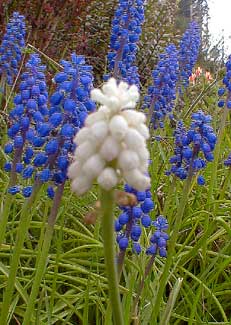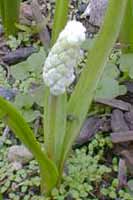
Pastel Muscari
"Soon as a flow'ret blooms in spring,
It wakens many a strain."
-Johann Wolfgang von Goethe
(1749-1832)
(1749-1832)
We planted several bulbs for a diminuative grape hyacinth in Autumn 2002, & they bloomed the following March & through early April.
 They did not make a great showing for their first year, but the foliage was very healthy, so we assumed they would be storing energy & would do much better come spring 2004. Unfortunately, I made a serious booboo. When lifting some narcissus bulbs to divide, & replanting them in a roadside sungarden, I apparently dug up the Muscari pallens too. They unexpectedly popped up the following spring in two locations out by the road.
They did not make a great showing for their first year, but the foliage was very healthy, so we assumed they would be storing energy & would do much better come spring 2004. Unfortunately, I made a serious booboo. When lifting some narcissus bulbs to divide, & replanting them in a roadside sungarden, I apparently dug up the Muscari pallens too. They unexpectedly popped up the following spring in two locations out by the road.One that was among the dwarf narcissi is shown as a small March budding flower on the right; another is shown as a mature April blossom on the left, with some roadside Muscari botryoides in the background.
When originally planted, I really had no idea how tiny they were going to be. They proved to be so small that they were difficult to keep track of. Eventually I hope I can get a lot more bulbs so I can create a fuller drift of pastel muscari, & will next time be much more careful of the location I select, so that something a scant two to four inches tall will not be lost in the landscape.
This muscari is native of the northern Caucasus Mountains & eastern Turkey. The bloom starts out as an exceedingly pale blue coloration, almost white, but quickly loses even the hint of blue as it fades to an "arctic ice" white. But some clones, including ours, show very little blue at all. The flower stalk occasionally, but not invariably turns deep brown or black, & at the very least is darker than the stems of other muscaris.
Summer heat can be harmful, so that a little bit of shade is helpful in lengthening the life of the blooms. It naturalizes easily by its own seeds & by offsets, though it is not an aggressive muscari the way Muscari botryoides can be, & it is considerably smaller.
Like other grape hyacinths, it is dormant in summer, & grows its grassy leaves in autumn. The leaves remain evergreen through winter, then blooms at the tail-end of winter or early spring.
We also grow a larger white muscari that is a very close look-alike for the pastel muscari, namely Muscari botryoides var alba known as "Pearls of Spain."